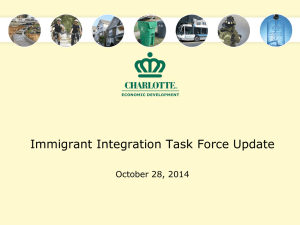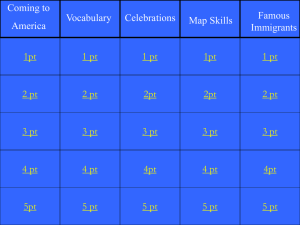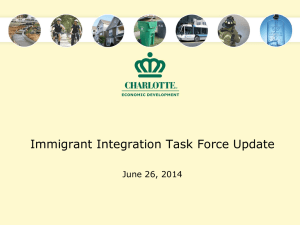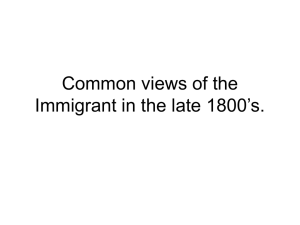A New Vision to Increase the Academic Achievement
advertisement
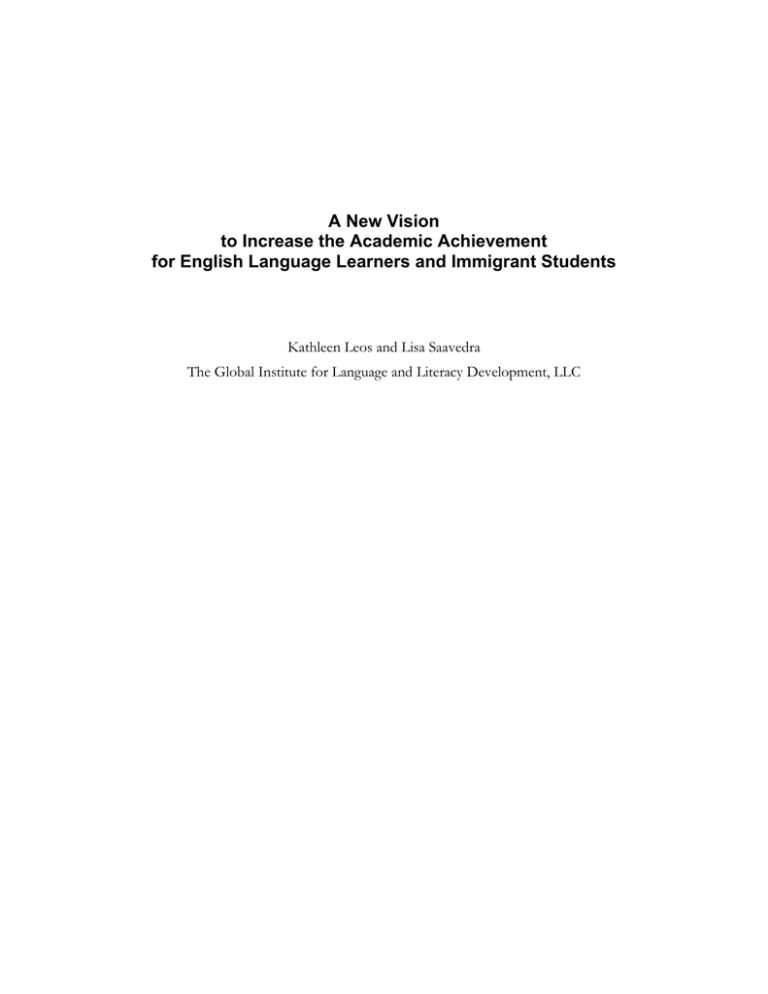
A New Vision to Increase the Academic Achievement for English Language Learners and Immigrant Students Kathleen Leos and Lisa Saavedra The Global Institute for Language and Literacy Development, LLC About the Roundtable on Young Children in Immigrant Families The goal of Young Children in Immigrant Families and the Path to Educational Success, a roundtable funded by the Foundation for Child Development and the Annie E. Casey Foundation, was to connect state and federal policy debates about early childhood education and education reform with emerging research about young children in immigrant families and what they and their families need to support their success at school in the United States. Specialists in education and early education—including researchers, key federal and state policy experts, and policymakers— came together for a day-long session with four closely related goals: to inform education and early education policymakers of the growing body of research about young children of immigrants; to educate researchers about policymakers’ needs; to build relationships between the two groups; and to generate specific, useful insights about the intersection of policy and research in this field. This report is one of several papers and policy briefs developed for the roundtable to provide the viewpoints of individual experts in order to stimulate group discussion, offer syntheses of the research on early education/pre-kindergarten and early elementary education as viewed by individual researchers and policymakers, and discuss the policy opportunities and challenges related to immigrant and ELL children age 3 to 8. The views of the papers’ authors catalyzed a rich discussion among roundtable participants. A synthesis report that brings together key themes from the whole session is forthcoming. The Global Institute for Language and Literacy Development, LLC, thanks Diane Staehr Fenner for her professional expertise and feedback on this paper . Copyright © October 2010. The Urban Institute. Permission is granted for reproduction of this file, with attribution to the Urban Institute. The Urban Institute is a nonprofit, nonpartisan policy research and educational organization that examines the social, economic, and governance problems facing the nation. The views expressed are those of the authors and should not be attributed to the Urban Institute, its trustees, or its funders. Contents A New Vision to Increase the Academic Achievement for English Language Learners and Immigrant Students 1 Goal and Challenge 1 Who the Children Are 2 Reauthorization Debate 3 The Legal Context: Framework and History 4 Results of the Legislation 6 The Evidence-Based Research: Recent History and Impact 7 Brain Research: Language Development and Language Acquisition 8 The Vision 9 References 10 Notes 12 A New Vision to Increase the Academic Achievement for English Language Learners and Immigrant Students This paper analyzes the challenges and opportunities posed by today’s education reform debate for the early education and language learning of immigrant, limited English proficient, and English language learner students 3 to 8 years old. Because of the close connections between the preschool and early elementary years, the paper addresses children who attend early childhood and kindergarten-through-3rd-grade education programs throughout the United States. The analysis focuses primarily on provisions in the Elementary and Secondary Education Act (ESEA) of 1965 (reauthorized as the No Child Left Behind Act, or NCLB, in 2001), as well as other relevant legislation and Supreme Court decisions that affect education of this student population. New, exciting solutions to educating English language learner (ELL) and immigrant students arise from creating a unified, coherent vision for early childhood and K–3 education by integrating evidence-based research with the education requirements outlined in NCLB. Historically, this integration has been difficult, if not impossible, to conceive—much less implement—given the paucity of available research, fragmented prior legislative history, and congressional interpretations of various Supreme Court mandates. However, the passage of NCLB and its detailed focus on student academic achievement, supported by an explosion of new scientific research related to the students’ complex linguistic and academic demands, presents an opportunity to transform education systems based on a vision for ELL and immigrant students’ educational attainment the moment they enroll in any early childhood or K–3 education setting. The key is merging the science with the law in a way that is student centered and developmentally and linguistically age appropriate. To begin, the paper defines the educational goals for the students by briefly summarizing the characteristics of young immigrant students and English language learners and their reported academic achievement to date. A short account of the current status of the ongoing ESEA and other legislative reform debates as it affects the students is included, as well as a deeper analysis into the two major challenges and potential opportunities: the legal (legislative and Supreme Court) history and context; and the challenging juxtaposition of new scientific knowledge, which offers numerous possibilities but had prior implementation limitations. The paper concludes with suggestions for educators, researchers, policymakers, and parents on how to attain the vision outlined in the paper and secure students’ academic future. Goal and Challenge As defined in ESEA, No Child Left Behind, and Title III legislation, the goal of education for English language learners and immigrant students and youth, in both early childhood education and kindergarten-to-3rd-grade classrooms, is to prepare students to enter and participate in school with the knowledge and skills necessary to achieve at the same high academic level that all students are expected to meet. The greatest challenge confronting educators, researchers, policymakers, and stakeholders is the lack of a shared, well-articulated vision that integrates early childhood education (ECE) with kindergarten-to-3rd-grade education for ELLs and immigrant students and addresses their fundamental educational needs based on new scientific research and current legislation. Integrating language development, language acquisition, and academic achievement into a new academic continuum would provide educators, students, and families an education structure on which to build a strong foundation of learning that targets the linguistic and academic dynamic inherent in the students’ early learning process. Who the Children Are An English language learner or limited English proficient (LEP) student, as defined by Title IX of ESEA, is a student between the ages of 3 and 21 who has difficulty “speaking, reading, writing, or understanding the English language” sufficient to deny the individual the “opportunity to participate fully in society” and the “ability to successfully achieve in classrooms taught in English” with no linguistic support.1 The student must also demonstrate the “ability to meet the state’s proficient level of achievement on state assessments” in academic content in English. Immigrant children and youth are defined in ESEA, NCLB, and Title III as “individuals who are aged 3 through 21; were not born in any state; and have not been attending one or more schools in any one or more state for more than three full academic years.”2 Note that not all immigrant students are ELLs. According to a recent report published by the Pew Hispanic Center (Fry 2008), English language learners and immigrant students and youth have been the fastest growing student subgroup in the United States for the past 10 years and continue to increase their annual enrollment by 10 percent. The same report states that the number of immigrant students and ELLs has increased dramatically from 1 in 10 students in U.S. classrooms in 1990 to 1 in 8 in 2005; it is projected to jump to 1 in 4 students by 2020 as the number of 3–21-year-olds increases from 12.3 million to 17.3 million. Most of the immigrant student and ELL population is Hispanic; 76 percent speak Spanish at home. However, more than 460 languages are represented in classrooms throughout the country (U.S. Department of Education 2008). Most ELLs attend public school and are enrolled in prekindergarten–3rd-grade classrooms. An increasing share (43%) of the 1.8 million first-generation immigrant students enters U.S. schools in middle and high school. Arizona, California, Florida, New York, and Texas educate approximately 70 percent of the country’s ELLs. Other states, such as North and South Carolina, Tennessee, Arkansas, and Georgia, have recently experienced a rapid increase (over 200%) in both ELL and immigrant student enrollment. Further analysis of various published data sources compiled by the Urban Institute reveals several new insights into the demographic characteristics of ELL and immigrant students and their families (Capps et al. 2005). Eighty-five percent of the students are born in the United States, are U.S. citizens, and enroll in kindergarten and 1st grade the same as their monolingual, Englishspeaking peers. An increasing number of ELL families now avail themselves of early childhood, Head Start, and other early learning programs. A report issued by Head Start in 2006 estimates that nearly 1 in 3 Head Start children age 3–4 come from families where a language other than English is spoken at home.3 In addition, a January 2010 report states that National Head Start Centers now serve over 1 million children and their families annually, with increasing numbers of ELL and immigrant students attending the center’s programs (Puma et al. 2010). Despite the increasing enrollment of ELLs and immigrant students in early childhood and prekindergarten–3rd-grade classrooms that may afford students additional instructional time, the academic achievement results of students who participate in standardized tests beginning in kindergarten remain dismal. The most current data published in the Early Childhood Longitudinal Study, Kindergarten (ECLS-K, 2009) underscores the growing achievement gap for ELLs and 2 immigrant students by following their academic performance from kindergarten to 5th grade. ELLs who entered kindergarten with limited English proficiency were in the lowest performing quartile in 5th-grade reading and math (Najarian, Pollack, and Sorongon 2009). Data released the same year by the National Assessment for Educational Progress (NAEP) in Reading and Mathematics illustrated that 4th- and 8th-grade ELLs lag far behind their English-proficient peers, with a staggering achievement gap hovering between 29 and 30 percent (National Center for Educational Statistics 2009a, 2009b). However, NAEP did not indicate whether these statistics included students who had been enrolled in any early childhood education programs. These statistics, combined with low graduation rates, low college placement rates, and the highest secondary school dropout rates (Fry 2003), have alarmed the education community, families, and advocates. All three groups are urgently examining all aspects of education research, policy, and practice to thoughtfully provide solutions that will reverse this trend for ELLs and immigrant students. Reauthorization Debate Three difficult jurisdictional challenges need to be addressed and resolved by Congress and various education stakeholders during the ESEA reauthorization debates in order for the community to develop a unified early-childhood–through–3rd-grade academic vision and establish a new education structure that changes the achievement trajectory of ELLs and immigrant students. First are the legal jurisdictional issues between the two federal agencies that educate the students. Second are the legal and possible constitutional issues that surface in ongoing debates related to federal versus states’ rights and local control of public education. The third challenge may be territorial as opposed to jurisdictional as education stakeholders from multiple communities confront a natural resistance to change while establishing a new, student-centered education system. Historically, educational opportunities have been offered to families with young children age 3–4 by the Department of Health and Human Services through National Head Start programs, while the educational needs of students age 5–8 have been addressed within the K–12 public school system under the jurisdiction of the Department of Education. For the education of ELL and immigrant students age 3–8 to change, the jurisdictional barrier between the two agencies needs to be dissolved, and Congress needs to consider the two student groups one cohesive unit. The two departments have the same vision, mission, and goals for the same group of students. In the past, however, they have not coordinated their efforts to address similar issues that affect students; at times, the agencies appeared to work at cross-purposes. On several occasions, Congress has discussed whether to move the National Head Start program and the Child Care Bureau into the U.S. Department of Education, to no avail. However, recent reports by both federal agencies list similar challenges within the same instructional areas for this student group. Now appears an optimal time for lawmakers and stakeholders to consider such a profound change on behalf of the students, since education is driven by evidence-based research and supported by the law. The second, and possibly more controversial, jurisdictional issue that needs a wellarticulated, transparent, and guided solution is the local control of public education and the role of the federal and state governments in a new educational entity for early-childhood–through–3rdgrade education. An example of the level of discussion and possible solutions can be found in the debate among educators and lawmakers concerning developing and adopting the national Common Core State Standards. In 2009, 48 state governors and chief state school officers signed an agreement to develop national academic standards for English language arts; mathematics; and 3 literacy in history/social studies, science, and technical subjects. These core standards would be benchmarked against international standards and include the knowledge and skills students need to compete academically and economically in the 21st century. The central issue for all students, including ELLs and immigrant students, is simple. The Constitution does not place public education under federal jurisdiction, and any right or privilege not authorized in the constitution defers to the states. States consider public education a state right, and many members of Congress are not ready to relinquish this right, as is implied by adopting the Common Core State Standards. Governors and school chiefs, on the other hand, are eager to adopt the standards as a response to rising high school dropout rates, the loss of the United States’ international competitive edge, and high school graduates who do not have the necessary skills to compete in an international economy because of state-developed academic standards that lack rigor. Adoption of the Common Core State Standards not only benefits all students but would directly influence higher academic achievement of ELLs and immigrant students. According to the recommendations detailed in the Obama administration’s Blueprint for Reform, states that adopt college- and career-ready standards should “develop and adopt statewide English language proficiency standards for English Learners, aligned so that they reflect the academic language necessary to master the state’s content standards” (U.S. Department of Education 2010a, 8). This effort would provide the students the linguistic breadth and depth to access academic content knowledge necessary to succeed. A feasible solution to the brewing controversy embedded in the constitutional federal-versus-states’-rights debate is for Congress to give states the option of adopting the national Common Core State Standards and corresponding English language proficiency standards, thereby never allowing the federal government to usurp states’ rights or interfere with local control of public education. The same concept and solution can be followed to allow states, districts, and communities to establish new directions for ECE and K–3 education. The third area that may present difficulties for educators to develop a unified, cohesive vision for early-childhood–to–3rd-grade education appears more territorial than jurisdictional. It is not clear that ECE and K–3 education stakeholders, educators, researchers, parents, and community advocates are fully aware of the legal implications mandated within the Supreme Court decisions as well as the legal requirements for ELL and immigrant students age 3–21 delineated in No Child Left Behind. At the same time, it appears that many of the same stakeholders are not yet familiar with and cognizant of the plethora of new evidence-based research available that targets language development and acquisition of children age 3–12 that can positively influence instruction for all students but specifically for English language learners. In the following sections of this paper, the legal requirements for ELLs and immigrant students and the history of their implementation will be outlined, followed by a brief synthesis of relevant research that applies to the unique learning dynamic of students and can form the foundation of a new vision of education to ensure their academic success. The Legal Context: Framework and History The education of immigrant students and ELLs has been guided primarily by three Supreme Court decisions that framed the issue within the context of the Civil Rights Act of 1964, which guaranteed students the equal opportunity to education by requiring access to education and academic content knowledge for “language minority children and students.”4 The first case, decided in 1974, was Lau v. Nichols, which declared “language minority students may not be denied access to educational 4 opportunities base on language or national origin.”5 The second case, Casteñeda v. Picard (1981), established three criteria or a three-prong approach for programs that educate students with “limited English proficiency,” stating that language instruction education programs must be based on “sound education theory” or current evidence-based research, “implemented effectively with adequate resources and personnel,” and “evaluated as effective in overcoming language barriers to ensure access to academic content in English.”6 The third case, Plyler v. Doe (1982), declared that immigrant children, whether U.S. citizens or not, must be provided an equal education as all other students and that sufficient funding may not be denied to ensure necessary resources were available to support equal access and an equal education, regardless of the students’ legal and/or immigration status. These three cases established the foundation for education policy and classroom practice that has influenced early childhood and pre-K–12 education systems for ELLs and immigrant students and youth to this day. One of the first pieces of legislation following the Civil Rights Act of 1964 that directly affected the education of students with limited English proficiency was the Bilingual Education Act, Title VII, authorized by Congress in 1968. This new law required states and districts to oversee the legislated requirements that mandated schools to provide bilingual education programs to “limited English proficient” students, the majority of whom were “immigrant children,” and awarded federal discretionary funds to school districts and schools that incorporated native-language instruction into their curricula. In its first year, the Bilingual Education Act funded 75 bilingual education programs and served students who spoke 14 different languages. Congress amended the act in 1982, offering Title VII programs the option of using English-only or English as a second language instruction. In 1983, the education winds in Washington, D.C., shifted with the release of “A Nation at Risk,” which found poor academic performance at every level of the education system and warned that “the educational foundations of our society are presently being eroded by a rising tide of mediocrity” (National Commission on Excellence in Education 1983, 1). This shocking exposé launched numerous iterations of education reform that culminated in the reauthorization of the Elementary and Secondary Education Act in 2001 as No Child Left Behind, which established high academic achievement, standards, and aligned systems as the cornerstone of education for all students, and held schools, districts, and state education agencies accountable to reach these goals. No Child Left Behind eliminated the Title VII Bilingual Education Act and replaced it with Title III, The English Language Acquisition, Language Instruction, and Academic Achievement Act. It also established the Office of English Language Acquisition to oversee the English language acquisition and high academic achievement of ELLs and immigrant students and youth, based on academic content and achievement standards and evidence-based research in K–12 education. As a result, beginning in fiscal year 2002, states were awarded federal formula grants to develop comprehensive systems of standards, assessments, and accountability specific to the linguistic and academic achievement goals for LEP and immigrant students and youth. Title III of No Child Left Behind required states to establish English language proficiency standards and objectives across grades K–12 derived from the four recognized language domains: speaking, listening, reading, and writing. States must also report on comprehension. These standards and objectives must be aligned with the achievement of challenging state academic content and student achievement standards that all students are expected to meet. Title III instantly became the purest expression of the Lau v. Nichols decision, which stated, “Language may not be a barrier to academic content knowledge and achievement,” by aligning language, content, and achievement systems based on standards and research. It was the first time that established law required ELLs and immigrant students and youth age 3–21 to attain the same achievement goals as all other students in the nation. 5 Results of the Legislation These extraordinary legal changes shifted ELL and immigrant student education from years of “access” to an equal education focused on descriptive inputs to requiring an “equal educational opportunity” for all students based on scientific research and objective achievement outputs or demonstrated results. Since NCLB went into effect in 2002, states, districts, schools, and ECE programs have struggled to design, develop, and implement the new integrated education systems and infrastructure required by law and based on research. The various levels of success and challenges in K–3 education for ELLs and immigrant students are detailed in a series of Title III evaluative briefs produced by the American Institutes of Research for the U.S. Department of Education (2010b, 2010c, 2010d) and based on data submitted by 50 state education agencies, Washington, D.C., and Puerto Rico. In January 2010, the U.S. Department of Health and Human Services also published a status report on the programmatic and implementation requirements for 3- to 4-year-old ELL and immigrant students in the National Head Start and Early Head Start Centers. The “evaluative snapshot” in both agencies reports is strikingly similar. The reports illustrate progress made in infrastructure development within ECE and K–3 education, but full implementation of a comprehensive system that embraces the linguistic and academic needs of ELLs and immigrant students based on current research is insufficient and incomplete within each federal agency’s jurisdiction. Remarkably, the reported results cite a litany of deficiencies in similar areas for both institutions, indicating that designing a new educational system for ELLs and immigrant students age 3–8 would certainly benefit the students. Thirteen obvious and glaring areas in need of attention are detailed in both reports: • Valid and reliable assessments that accurately indicate the level of language proficiency • Valid and reliable assessments that identify ELL students for recommended placement in language education instruction programs (both federal agencies) • Professional knowledge about evidence-based language development programs • Complete data systems development • Professional knowledge and understanding of standards-based instruction • Professional knowledge and understanding of standards-based development in both language and academic content • Professional knowledge and expertise related to preliteracy and content standards that include information relevant to the students’ culture, language, background, learning style, and learning processes • Professional development that is relevant and supports staff understanding and knowledge on standards-based instruction, choosing evidence-based research curriculum, assessments, accommodations, and supplemental materials • Professional knowledge and expertise related to assessments: placement, formative, and summative, and how to use data to support teaching strategies 6 • Professional knowledge and expertise in understanding aligned systems and how they function • Professional knowledge and expertise in understanding how to choose what works for which students in different academic environments • Administrative support: understanding the legal requirements for ECE, Head Start, ESEA, and Title I, II, III, and IX • A sufficient number of highly qualified, experienced, highly trained teachers, professional staff, paraprofessionals, ancillary staff, and administrators that can address the academic and developmental needs of the student population The list of hurdles and barriers appears daunting. But inherent in the challenge is the opportunity and ultimately the solution to profoundly change the direction of ELL and immigrant student academic achievement. Merging the new scientific research with a complete implementation of the required infrastructure or aligned system and designing the new ECE–3rd-grade “learning foundation” for 3–8-year-olds using ESEA’s Title IX legal definition of the student group is the place to start. The Evidence-Based Research: Recent History and Impact Since 2002 and the passage of NCLB, education scientists have raced to produce quality evidencebased research that supports educators’ decisions about how to best instruct and assess students, including ELLs and immigrant students. This research on “what works” in education was based on data analysis and objective evidence gleaned from randomized control trials in scientific projects. The new highly organized approach was encouraged in the 2002 ESEA reauthorization, which established the first federal education research institute, The Institute of Education Sciences (IES). IES modeled its approach to developing, awarding, and overseeing research projects based on the “gold” standard criteria used in the medical field. The initial attempt was not without its critics and controversy; however, the new approved methodology stimulated quality research for education that influenced many other institutions supporting education research. It was the dawning of a new day for science in education. Of special interest for the education of English language learners and immigrant students was the quality and quantity of evidence-based research that needed its own unique focus in every area of education, given the paucity of science that had been verified, published, and disseminated before NCLB. Since 2002, when NCLB required states, districts, schools, and educators to make informed academic decisions from scientific analysis, the number of research studies specific to the education of ELLs and immigrant students has exploded. The list now seems endless. However, it is important for education stakeholders to understand and consider the breadth and depth of research necessary to build an academic system founded on science that embodies the complex dynamic of the confluence of academic and linguistic needs inherent in how and what students need to learn and master. The history of recent, influential evidence-based research that initially had an indirect impact on ELLs and immigrant students begins with the studies published in 2000 by The National Reading Panel (NRP). “Teaching Children to Read” outlined five distinct skills that monolingual Englishspeaking students need to explicitly learn to become proficient readers in English: phonemic 7 awareness, phonics, fluency, vocabulary, and comprehension. This publication turned the education world upside down for years and sparked a firestorm of controversy that has lasted to this day. Although evidence-based solutions supporting new directions in reading instruction were embraced for English speakers, questions related to research-based reading instruction for students with different heritage languages or ELLs and immigrant students remained. Soon after the NRP published its work, a second panel, The National Literacy Panel (NLP), was commissioned in 2002 to conduct a literature review for Spanish-speaking students to discover the most effective evidence-based reading instruction practices and strategies that would increase reading achievement in English. The NLP was at a distinct disadvantage: only 70 studies met the same evaluation criteria and could be analyzed as opposed to the 400 studies that had been evaluated by the NRP. In 2006, the National Literacy Panel published its findings in “Developing Literacy in Second-Language Learners,” citing the same reading skills (phonemic awareness, phonics, fluency, vocabulary, and comprehension) that need to be explicitly taught for ELLs to become proficient readers regardless of the language of instruction. The NLP tried to review research studies pertinent to second-language acquisition and language education instruction programs, or “program approach,” but could not definitively recommend a specific methodology because not enough research studies met the panel’s criteria. Consequently, the panel recommended providing additional federal funding for ongoing quality research in these and other critical areas. However, IES targeted federal research grants to fund projects for ELLs’ reading development and deferred research in language development and language acquisition to the cognitive scientists or the “brain development” researchers and the neurolinguists in the medical research community.7 Brain Research: Language Development and Language Acquisition ELLs are tasked to develop three distinctly different learning skill sets simultaneously—reading (product) and language development and language acquisition (process)—to become successful lifelong academic learners and thinkers. Educators are tasked to understand how to teach foundational language development skills fused through the lens of language acquisition aligned to the academic content areas at each grade level. This is no easy task, but the process allows the student to learn language and content at a meta-cognitive level and deepen comprehension while increasing cognitive capacity. It is not enough to only teach reading skills in one or two languages or to concentrate solely on academic vocabulary. The key to comprehending academic content is through developing and manipulating language in its various forms, and the earlier a student can master this complex process in any language or multiple languages, the greater the impact on brain functioning and comprehension. The importance of early language development cannot be overstated by neuroscientists who study the interconnected functioning of language development on brain development and comprehension in children age 3–8, a time when the brain is biologically equipped to best learn language(s) that affect cognitive capacity. These specific findings have been demonstrated in multiple evidence-based studies conducted at several research university labs and emphasize how the brain encodes words and develops networks to produce language, which in turn affects comprehension (e.g., Bialystok 2001; Buteau and Kohnert 2000; Kohnert 2004). The studies indicate the importance of language development, regardless of the language or the number of languages learned, which must be fostered early in children or will be lost. 8 Another team of researchers who understands the importance of language development and its impact on comprehension is led by famed researcher Dr. Catherine Snow at Harvard University, who chaired the Carnegie Foundation–funded three-year study on adolescent literacy. These researchers stressed the point in the new published study, “Time to Act: An Agenda for Advancing Adolescent Literacy for College and Career Success” (2010); as eloquently stated by Dr. Snow at the publication’s release, “It’s all about language” as “language development is the key to comprehension.” In a previous groundbreaking study, “What Teachers Need to Know,” Dr. Snow and Dr. Wong Fillmore (2000) delineated the depth and breadth of language development knowledge and skills that all classroom teachers must understand and use in everyday classroom instruction for students, including ELLs and immigrant students, to master academic knowledge at grade level. The body of evidence-based scientific knowledge specific to language development and increased comprehension is significant. Scientists worldwide have been studying this area of brain development for many years. It is difficult in this short paper to include the numerous researchers who have spent countless hours learning how the brain functions, how developing language skills is the single most important factor to developing knowledge, and how learning language or acquiring multiple languages while comprehending what is being learned is vital for all students in developing strong academic skills. Suffice it to say that all facets of U.S. public education are just beginning to recognize and understand the important influence integrating this relatively new science into classroom instruction can have on supporting a students’ quest to a deeper understanding of written text and expression at every level and its role in academic achievement. The Vision What years of study, evaluation, and analysis suggest is a unique opportunity for education stakeholders to design a seamless early-childhood–to–3rd-grade learning environment for 3–8-yearold ELLs and young immigrant students that develops language(s) and content knowledge simultaneously. These students would be educated in a well-articulated and developmentally appropriate academic continuum that incorporates evidence-based brain research in language development and language acquisition with the full implementation of the legal requirements described in No Child Left Behind, using the common definition of ELL and immigrant students in ESEA, Title IX, and Title III as the legal justification and foundation on which to build. Such an extraordinary commitment made by dedicated educators, researchers, parents, and specialists would have a profound impact on the students’ academic future and ensure the nation’s next generation of learners their civil rights in education. The Global Institute for Language and Literacy Development, LLC, and its dedicated group of expert collaborators stand poised to work with all stakeholders to change the trajectory of education in the United States for English language learners and immigrant students, to help the students fulfill their academic dreams. GILD would like to thank the Urban Institute for allowing participation in such an important endeavor with diverse professionals who have dedicated their lives to meeting the academic goals of ELLs. 9 References Bialystok, Ellen. 2001. Bilingualism in Development: Language, Literacy, and Cognition. New York: Cambridge University Press. Buteau, Carol Liddiard, and Kathryn Kohnert. 2000. Preschoolers Acquiring Language Skills: A CenterBased Curriculum with Parents as Partners (PALS). Eau Claire, WI: Thinking Publications. Capps, Randy, Michael Fix, Julie Murray, Jason Ost, Jeffrey S. Passel, and Shinta Herwantoro. 2005. The New Demography of America’s Schools: Immigration and the No Child Left Behind Act. Washington, DC: The Urban Institute. Carnegie Council on Advancing Adolescent Literacy. 2010. Time to Act: An Agenda for Advancing Adolescent Literacy for College and Career Success. New York: Carnegie Corporation of New York. Fry, Richard. 2003. Hispanic Youth Dropping Out of U.S. Schools: Measuring the Challenge. Washington, DC: Pew Hispanic Center. http://pewhispanic.org/files/reports/19.pdf. ———. 2008. The Role of Schools in the English Language Learner Achievement Gap. Washington, DC: Pew Hispanic Center. http://pewhispanic.org/reports/report.php?ReportID=89. Kohnert, Kathryn. 2004. “Children Learning a Second Language: Processing Skills in Early Sequential Bilinguals.” In Bilingual Language Development and Disorders in Spanish-English Speakers, edited by Brian A. Goldstein (53–76). Baltimore: Brookes Publishing. Najarian, Michelle, Judith M. Pollack, and Alberto G. Sorongon. 2009. Early Childhood Longitudinal Study, Kindergarten Class of 1998–99 (ECLS-K): Psychometric Report for the Eighth Grade. NCES 2009-002. Washington, DC: National Center for Education Statistics. National Center for Educational Statistics. 2009a. The Nation's Report Card: Mathematics 2009. NCES 2010-451. Washington, DC: U.S. Department of Education, Institute for Education Sciences. ———. 2009b. The Nation's Report Card: Reading 2009. NCES 2010-458. Washington, DC: U.S. Department of Education, Institute for Education Sciences. National Commission on Excellence in Education. 1983. A Nation at Risk: The Imperative for Educational Reform. Washington, DC: U.S. Department of Education. Puma, Michael, Stephen Bell, Ronna Cook, and Camilla Heid. 2010. Head Start Impact Study: Final Report. Rockville, MD: U.S. Department of Health and Human Services, Administration for Children and Families, Office of Planning, Research, and Evaluation. U.S. Department of Education. Office of English Language Acquisition, Language Enhancement, and Academic Achievement for Limited English Proficient Students. 2008. The Biennial Report to Congress on the Implementation of Title III State Formula Grant Program, School Years 2004– 06. Washington, DC: U.S. Department of Education. http://www.ncela.gwu.edu/files/uploads/3/Biennial_Report_0406.pdf. 10 U.S. Department of Education. Office of Planning, Evaluation, and Policy Development. 2010a. A Blueprint for Reform: The Reauthorization of the Elementary and Secondary Education Act. Washington, DC: U.S. Department of Education. http://www2.ed.gov/policy/elsec/leg/blueprint/. ———. 2010b. “Title III Policy: State of the States.” ESEA Evaluation Brief: The English Language Acquisition, Language Enhancement, and Academic Achievement Act. Washington, DC: U.S. Department of Education. http://www.air.org/files/Title_III_State_of_the_States_043010_r1.pdf. ———. 2010c. “Title III Accountability: Behind the Numbers.” ESEA Evaluation Brief: The English Language Acquisition, Language Enhancement, and Academic Achievement Act. Washington, DC: U.S. Department of Education. http://www.air.org/files/Title_III_Behind_the_Numbers_043010.pdf. ———. 2010d. “Title III Accountability and District Improvement Efforts: A Closer Look.” ESEA Evaluation Brief: The English Language Acquisition, Language Enhancement, and Academic Achievement Act. Washington, DC: U.S. Department of Education. http://www.air.org/files/Title_III_District_Improvement_043010.pdf. Wong Fillmore, Lily, and Catherine Snow. 2000. “What Teachers Need to Know about Language.” Washington, DC: U.S. Department of Education, Office of Educational Research and Improvement, Educational Resources Information Center. 11 Notes 1 The Elementary and Secondary Education Act (ESEA), P.L. 89-10, 79 Stat. 27, 20 U.S.C. ch. 70 (1965). 2 No Child Left Behind (NCLB) Act of 2001, P.L. 107-110, § 115, Stat. 1425 (2002). 3 Data taken from figures in the 2006–07 Head Start Program Information Report data collection. 4 The Civil Rights Act of 1964, P.L. 88-352, 78 Stat. 241 (1964). 5 Lau v. Nichols, 414 U.S. 563 (1974). 6 Casteñeda v. Pickard, 648 F.2d 989 (U.S. Court of Appeals, Fifth Circuit. 1981). A complete list of IES-funded ELL reading-research projects is available on the IES web site at www.whatworks.ed.gov/. 7 12

